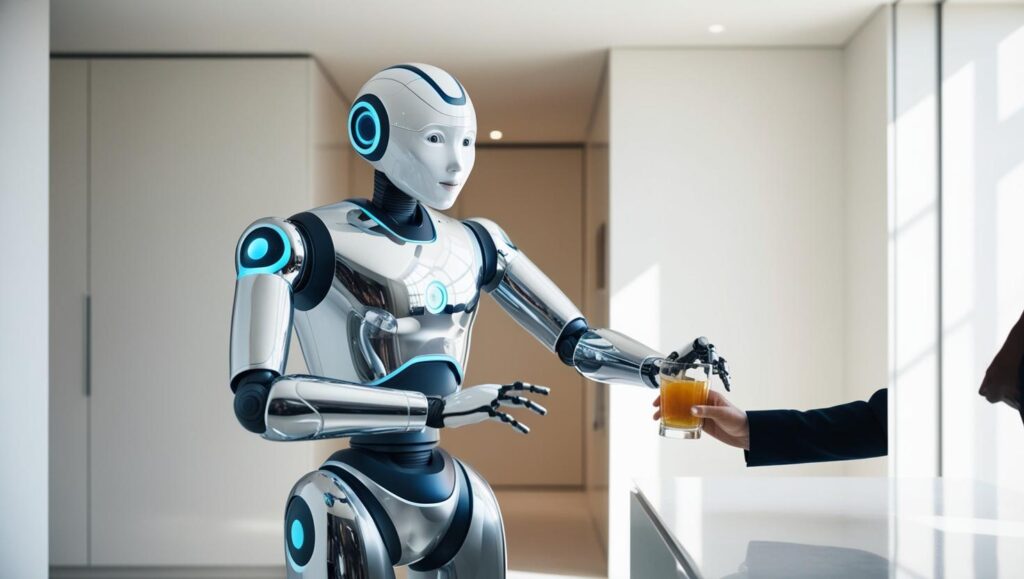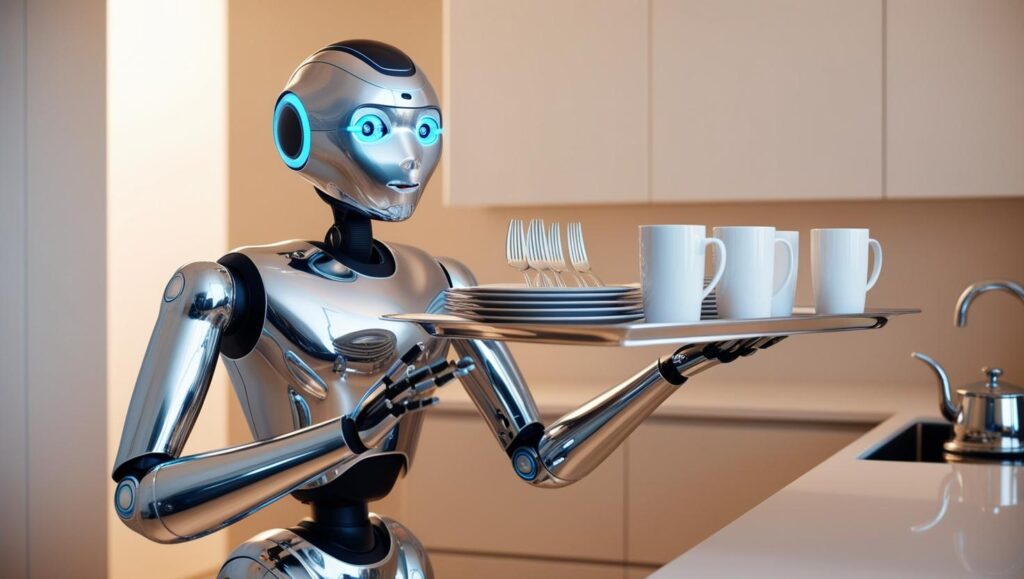The US Service Robotics Market is experiencing a transformative phase, driven by rapid technological advancements and increasing demand for automation across various sectors. Service robotics, encompassing robots designed to assist humans in professional and personal tasks, is reshaping industries such as healthcare, logistics, agriculture, and hospitality. This article provides a comprehensive analysis of the US Service Robotics Market, delving into its current landscape, growth drivers, technological innovations, applications, and future projections. With a focus on maintaining an SEO-friendly structure, the content incorporates the primary keyword “US Service Robotics Market” naturally, alongside secondary keywords like service robots, automation, robotics technology, and AI-driven robotics, to enhance visibility and relevance.
The service robotics market is projected to expand from USD 47.10 billion in 2024 to USD 98.65 billion by 2029, growing at a robust compound annual growth rate (CAGR) of 15.9% during the forecast period.
Understanding the Scope and Significance of the US Service Robotics Market
The US Service Robotics Market represents a dynamic segment within the broader robotics industry, characterized by robots engineered to perform tasks that enhance efficiency, safety, and productivity. Unlike industrial robots, which are typically confined to manufacturing environments, service robots operate in diverse settings, including homes, hospitals, warehouses, and public spaces. These robots are designed to interact with humans, often incorporating advanced technologies such as artificial intelligence (AI), machine learning, and the Internet of Things (IoT). This growth reflects the market’s ability to address societal challenges, such as labor shortages, aging populations, and the need for contactless operations, particularly in the wake of the COVID-19 pandemic. The versatility of service robots, coupled with their ability to reduce human error and operational costs, positions the US Service Robotics Market as a cornerstone of modern automation.

Key Drivers Fueling Expansion in the US Service Robotics Market
Several factors are propelling the US Service Robotics Market forward, creating a fertile ground for innovation and investment. One of the primary drivers is the growing demand for automation across industries. Businesses are increasingly turning to service robots to streamline operations, reduce labor costs, and enhance productivity. In sectors like logistics and warehousing, the rise of e-commerce has intensified the need for autonomous mobile robots (AMRs) that can handle tasks such as picking, packing, and inventory management. Similarly, the healthcare sector is witnessing a surge in demand for medical robots that assist in surgeries, patient monitoring, and rehabilitation, addressing the challenges of an aging population and staffing shortages. The US Service Robotics Market is also benefiting from supportive government policies and investments in research and development, which foster technological advancements and market competitiveness. Additionally, the integration of 5G technology and edge AI chips is enhancing the performance of service robots, enabling real-time data processing and seamless connectivity. These drivers collectively underscore the robust growth trajectory of the US Service Robotics Market, positioning it as a critical component of the nation’s technological landscape.
Technological Innovations Shaping the Future of the US Service Robotics Market
Technological advancements are at the heart of the US Service Robotics Market, driving the development of more sophisticated and versatile robots. Artificial intelligence plays a pivotal role, enabling robots to perform complex tasks with greater autonomy and precision. For instance, AI-powered service robots in healthcare can analyze patient data, assist in diagnostics, and provide personalized care, while those in logistics use machine learning to optimize delivery routes. The incorporation of IoT allows service robots to collect and analyze vast amounts of data, facilitating predictive maintenance and operational efficiency. Another significant innovation is the development of collaborative robots, or cobots, which work alongside humans in shared environments, enhancing productivity without compromising safety. The US Service Robotics Market is also witnessing advancements in computer vision and sensor technologies, which enable robots to navigate complex environments and interact with objects more effectively. These innovations are not only expanding the capabilities of service robots but also broadening their applications, making the US Service Robotics Market a hub of cutting-edge technology.
Diverse Applications Transforming Industries in the US Service Robotics Market
The US Service Robotics Market is characterized by its wide-ranging applications, which span both professional and personal domains. In healthcare, service robots are revolutionizing patient care by assisting in minimally invasive surgeries, monitoring vital signs, and providing companionship to elderly patients. The logistics sector relies heavily on service robots for warehouse automation, with AMRs and drones streamlining inventory management and last-mile delivery. In agriculture, precision farming robots equipped with sensors and AI are optimizing crop yields and reducing resource wastage, addressing the challenges of food security and sustainability. The hospitality industry is also embracing service robots to enhance guest experiences, with robots handling tasks such as room service, cleaning, and customer interactions. Additionally, the defense and security sectors are deploying service robots for tasks like bomb detection and surveillance, enhancing safety and efficiency. The versatility of these applications underscores the transformative potential of the US Service Robotics Market, as it continues to redefine operational paradigms across industries.
Regional Dynamics and Competitive Landscape of the US Service Robotics Market
The US Service Robotics Market is geographically diverse, with key regions such as California, Texas, and New York emerging as hubs of innovation and adoption. California, home to Silicon Valley, leads in research and development, with numerous startups and established companies driving advancements in robotics technology. Texas, with its strong industrial base, is witnessing significant adoption of service robots in logistics and manufacturing, while New York’s healthcare sector is a major consumer of medical robots. The competitive landscape of the US Service Robotics Market is marked by the presence of both established players and emerging innovators. Companies like Intuitive Surgical, iRobot, and ABB are leading the market with their cutting-edge solutions, while startups such as KEENON Robotics and Berkshire Grey are introducing novel technologies. Strategic partnerships, mergers, and acquisitions are common in the US Service Robotics Market, as companies seek to expand their market presence and enhance their product offerings. This competitive environment fosters continuous innovation, ensuring that the US Service Robotics Market remains at the forefront of global robotics advancements.
Challenges and Opportunities in the US Service Robotics Market
While the US Service Robotics Market is on a growth trajectory, it faces several challenges that could impact its expansion. One significant challenge is the high initial cost of service robots, which can deter small and medium-sized enterprises from adopting these technologies. Additionally, concerns around data privacy and cybersecurity are critical, as service robots often rely on cloud-based systems and IoT connectivity, making them vulnerable to breaches. Psychological barriers, such as resistance to human-robot interaction, also pose challenges, particularly in sectors like healthcare and hospitality, where trust and acceptance are paramount. However, these challenges are accompanied by substantial opportunities. The US Service Robotics Market can capitalize on the growing demand for automation in emerging sectors like smart cities and retail, where robots can enhance public services and customer experiences. Furthermore, advancements in AI and 5G technology present opportunities to develop more cost-effective and efficient robots, broadening their accessibility. By addressing these challenges and leveraging these opportunities, the US Service Robotics Market can sustain its growth momentum.

Future Projections and Trends in the US Service Robotics Market
The future of the US Service Robotics Market is promising, with projections indicating robust growth over the next decade. This growth will be driven by the increasing adoption of service robots in both professional and consumer applications, fueled by advancements in AI, IoT, and 5G connectivity. Emerging trends in the US Service Robotics Market include the rise of autonomous delivery robots, which are gaining traction in urban areas for last-mile delivery services. The integration of service robots with smart home technologies is another trend, with consumer robots like robotic vacuum cleaners and lawnmowers becoming increasingly popular. Additionally, the focus on sustainability is driving the development of eco-friendly robots that minimize energy consumption and environmental impact. These trends highlight the evolving nature of the US Service Robotics Market, as it adapts to changing consumer needs and technological advancements.
Regulatory Framework and Ethical Considerations in the US Service Robotics Market
The US Service Robotics Market operates within a complex regulatory framework that governs the development, deployment, and operation of service robots. Regulatory bodies such as the Federal Aviation Administration (FAA) and the Food and Drug Administration (FDA) oversee specific applications, such as drones and medical robots, ensuring safety and compliance. Data privacy regulations, including the California Consumer Privacy Act (CCPA), are also critical, as service robots often collect and process sensitive information. Ethical considerations, such as the impact of automation on employment and the potential for bias in AI-driven robots, are gaining prominence in the US Service Robotics Market. Companies are increasingly adopting ethical guidelines to ensure responsible development and deployment of service robots, addressing concerns around transparency, accountability, and inclusivity. By navigating these regulatory and ethical challenges, the US Service Robotics Market can build trust and foster widespread adoption, ensuring sustainable growth.
Strategies for Success in the US Service Robotics Market
To thrive in the competitive US Service Robotics Market, companies must adopt strategic approaches that align with market trends and consumer needs. Investing in research and development is crucial for staying ahead of technological advancements and delivering innovative solutions. Collaborations with academic institutions and technology partners can accelerate innovation, enabling companies to develop cutting-edge robots tailored to specific industries. Additionally, focusing on user-centric design is essential for enhancing human-robot interaction and overcoming psychological barriers. Companies should also prioritize affordability, exploring cost-effective manufacturing processes and scalable solutions to broaden market access. Leveraging data analytics and IoT can further enhance the performance of service robots, providing actionable insights for predictive maintenance and operational optimization. By adopting these strategies, businesses can position themselves as leaders in the US Service Robotics Market, capitalizing on its vast potential.
Global Context and the Role of the US Service Robotics Market
The US Service Robotics Market operates within a global ecosystem, where it plays a leading role due to its technological prowess and innovation-driven economy. The US Service Robotics Market benefits from its strong infrastructure, skilled workforce, and robust investment in AI and robotics research. Compared to regions like Asia Pacific, which dominates in market share due to high robot density in countries like Japan and South Korea, the US excels in pioneering new applications and technologies. The US Service Robotics Market is also influencing global trends, with American companies setting standards in areas like medical robotics and autonomous delivery. By maintaining its leadership in innovation and fostering international collaborations, the US Service Robotics Market is poised to shape the future of global robotics.